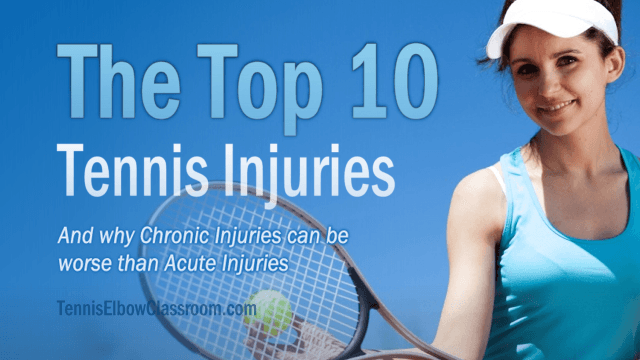And Why Chronic Injuries Can Be Worse Than Acute Injuries
This top 10 list is actually two “top 5” lists in one: The top 5 chronic / overuse injuries and the top 5 acute injuries. Injuries that are often lumped together but which have very different origins and require different treatment protocols.
Acute injuries happen suddenly due to a fall, collision or sudden overload of a body part, like a sprain that results from rolling an ankle – and they are (usually) immediately recognizable as injuries.
With chronic / “overuse” injuries the damage happens gradually, rather than suddenly – and although they’re technically not as serious as acute injuries, they’re more likely to be initially overlooked, improperly treated, and more difficult to heal.
Tennis Elbow is the most well-known chronic injury plaguing tennis players – And it’s notoriously hard to recover from (unless you have the Tennis Elbow Classroom Self-Help Program, of course!)
The Terrible 10: 5 Chronic + 5 Acute Tennis Injuries
The most common and most serious tennis-related cumulative, chronic or “overuse” injuries are:
- Tennis Elbow and Golfer’s Elbow
- Rotator Cuff Tendinopathies
- Patellar Tendinopathies
- Achilles Tendinopathies
- Stress Fractures
Followed by the Top 5 Acute Trauma Tennis Injuries: Top Five Acute Tennis Injuries:
- Torn Cartilage
- Dislocations / Separations (often the shoulder)
- Sprains – (Torn ligaments)
- Achilles Tendon Rupture
- Strains – (Torn tendons)
One of my motivations to write this article came when I stumbled across an article from Tennis World USA, about common tennis injuries and noticed it was a mix of Acute and Chronic injuries.
The Top Five Chronic / Overuse Tennis Injuries
Again, with these injuries the damage happens gradually over weeks, months or years – not suddenly. They sneak up on you like a thief in the night.
Occasionally, the symptoms may appear suddenly (although the pain is more likely to ramp up gradually) but the injury process or damage itself happens slowly.
And it’s very common for the pain and other symptoms to come and go or intensify and lessen from day to day or week to week – Especially the first four.
What the first four have in common is they are all forms of ‘Tendinopathy.’
A Tendinopathy is a non-specific, cumulative or “repetitive strain” tendon injury – It’s usually chronic (long-term) not acute (sudden trauma.)
Sometimes, persistent tendon overload/overuse results in ‘Tendonitis,’ a chronic irritation or inflammation.
But Tendonitis is a very often a faulty assumption or outright mis-diagnosis, since medical research has conclusively shown that these Tendinopathies most often come in the form of Tendinosis; they are degenerative in nature – Not inflammatory.
At first glance, this might not seem like an important distinction; Tendonitis vs. Tendinosis / inflammatory vs. degenerative.
Isn’t a tendon injury a tendon injury? Absolutely not!
Inflammation in or around an injured or irritated tendon ‘Tendonitis’ is a much less serious condition (since inflammation is a stage in the healing process of tissues, like muscles, tendons and ligaments.)
Degeneration, in contrast, is a much more serious problem, since it means the healing process is failing and the tissue is breaking down instead of being repaired. (There is a distinct absence of inflammation in the case of degeneration / Tendinosis.)
In my experience, the failure to recognize and grasp this distinction and to take the right action (treat it the right way) is a large part of the reason WHY these injuries ARE so notoriously hard to recover from, and why they often become so chronic in the first place.
And despite decades of medical research presenting copious, clear (overwhelming?) evidence that many if not most of these Tendinopathies are degenerative in nature – and not inflammatory – change in official medical treatment protocols is abysmally glacial.
1. Tennis Elbow And Golfer’s Elbow
Since this is a website about Golfer’s and Tennis Elbow, let’s talk about these vexing injuries first.
Tennis Elbow is usually a chronic tendon injury to the tendons of the ‘Wrist Extensor’ muscle group. (The ‘Common Extensor Origin’ in particular.)
For a more detailed view, see this video post: What IS Tennis Elbow?
Lateral Epicondylitis is the old technical term for it, (suggesting chronic inflammation) but Epicondylopathy is replacing it (suggesting a non-specific tendon injury / Tendinopathy.)
Extensive research has shown that it’s most likely to be Tendinosis, which means the damage is degenerative – Not inflammatory. See this post with video and references:
Tossing The Tendonitis Myth – Why Tennis Elbow Is NOT Inflammatory
Tennis, via gripping, controlling and swinging of the tennis racket, (plus impact stress of hitting the ball) puts considerable demand on the muscles in the forearm that move and stabilize the wrist.
The tendon anchor spot (Common Extensor Origin) at the bony knob on the outside of the elbow area (Lateral Epicondyle) is where the worst symptoms are usually felt.
The essence of the injury when it’s chronic is that this tendon group breaks down faster than it gets repaired due to overload.
What about playing tennis while you’re injured and still recovering from Tennis Elbow?
Is that something to be avoided or can you still play if you’re careful? (See article linked above.)
2. Rotator Cuff Tendinopathies
Several different things can go wrong (cumulatively) in the tendons of the Rotator Cuff.
The most common Tendinopathies are: Tendonitis, Tendinosis, Impingement Syndromes and “partial thickness tears.”
If there is a mild to moderate tear / minor “partial thickness tear” to one of these tendons that is the most serious.
This can happen as a result of gradual weakening of the tendon (Cumulative Trauma) which is why it’s in this category.
If it happens suddenly, say, right there on the court during a match, it would be an Acute Trauma injury and would belong in that category.
But even if a tear does occur suddenly, it’s still very likely that gradual wear and tear and/or degeneration of the delicate Rotator Cuff tendons weakens them first, setting a tennis player up for a sudden tear (strain.)
Impingement Syndrome is a common dysfunction that affects only 1 of the 4 tendons of the Rotator cuff, the Supraspinatus.
Shoulder Impingement Video – Dr. Richard Hawkins
In the video below, Dr. Richard Hawkins with the Steadman Hawkins Clinic discusses shoulder impingement and it’s treatment options:
Impingement Syndrome is a gradual, cumulative injury involving the upper-most Rotator Cuff Tendon, the ‘Supraspinatus.’
The Supraspinatus is the only tendon of the Rotator Cuff that passes through a “bony passageway” (formed by the Acromion Process, above it and the head of the Humerus, below it)
If this bony space narrows or the tendon thickens within it the tendon gets compressed and the friction upon it increases.
With increased friction comes irritation then inflammation and swelling. The worst thing about this is that in the limited space the tendon has, swelling increases the pressure and friction, which feeds and becomes a vicious cycle.
It’s a cycle that can occur and get serious fairly quickly in a sport like tennis, because tennis involves so much repetitive, dynamic shoulder activity – Especially the overhead activity inherent in the service motion.
In my experience, Rotator Cuff injuries, in all their permutations, are the worst injuries in this list – and, in my opinion, they are often the most poorly treated when it comes to conventional medicine.
See also this article on Rotator Cuff Exercise Myths And Risk
(Which is especially for Tennis Elbow sufferers and covers the 4 muscles of the Rotator Cuff and their functions.)
3. Patellar Tendinopathies
The Patella is the technical name for the kneecap, and the Patellar Tendon is the tendon beneath the kneecap that connects it to the primary bone of the leg, the Tibia.
Biomechanically, the force generated by the Quadriceps Muscle, (four part muscle in the front of the thigh) is first transmitted trough the Quadriceps Tendon to the Patella and then through the Patellar Tendon to the Tibia.
All the running, quick starting and stopping, and direction changes inherent in the game of tennis can be very hard on the joints of the lower body, and the Patellar Tendon of the knee (and the knee in general) is right in the middle of the action.
Like the other Tendinopathies, it can manifest as either Tendonitis or Tendinosis, but the more chronic the injury (the more persistent and long-standing) the more likely it is to be Tendinosis (degeneration of the tendon.)
4. Achilles Tendinopathies
The Achilles Tendon is the largest tendon in the human body connecting two large calf muscles (Gastrocnemius and Soleus) to the heel.
With every change in direction and stance on the court the muscles and tendons in the calf must adapt to or carry out every change in foot and ankle position.
The Achilles Tendon carrying the biggest load. (Is there a muscle and tendon that works harder in tennis? Probably not!)
This is an incredibly strong, resilient and adaptable muscle and tendon group – but, like all tissues of the body, has it’s limits.
Again, as with the other chronic tendon injuries, it can manifest as either Tendonitis or Tendinosis, but the more chronic the injury becomes the more likely it is to become degenerative (Tendinosis.)
Weakening of this tendon can and, unfortunately, all too often does result in tearing – Sometimes in a mild or moderate tear, but often in a dramatic and terrible rupture. (See The Top 5 Acute Tennis Injuries below.)
5. Stress Fractures:
When I researched this article I was very surprised to see Stress Fractures listed as one of “The Five Most Common Tennis Injuries” by Tennis World.
Never having come across a tennis player with this injury, I looked this up and found this study, stating that:
“Of the case reports, the most common condition in the upper extremity injury section was stress fractures (14 case reports).”
British Journal of Sports Medicine 2006;40:415-423 doi:10.1136/bjsm.2005.023184
Tennis injuries: occurrence, aetiology, and prevention
Stress fractures are a form of cumulative bone trauma in comparison to Acute Fractures, which are sudden complete or partial breaks in a bone.
Stress Fractures happen when bone inadequately adapts and rebuilds in response to mechanical load during physical exertion.
“Honorable Mentions” (Other Overuse Injuries / Syndromes)
There are many more Chronic / Overuse Injuries that often afflict tennis players. Here is a partial list of some of the more common ones:
- Frozen Shoulder / Adhesive Capsulitis (not as common)
- IT Band Syndrome (not necessarily an injury, per se)
- Plantar Fasciitis (a foot injury or pain syndrome)
- Shin Splints (leg injury pain / syndrome)
- Bursitis (inflammation + swelling of fluid-filled sacs called Bursae)
Top Five Acute Trauma Tennis Injuries
Acute injuries are of abrupt onset – They are sudden and immediately traumatic. (A secondary meaning of ‘Acute’ refers to the initial stage of healing – and a tertiary meaning has to do with symptoms, as in an “acute flare up” or intense period of symptoms.)
“Acute means sudden or severe. Acute symptoms appear, change, or worsen rapidly. It is the opposite of chronic.” – MedlinePlus
The upside of an acute injury is that (with rare exception) you know right away you’re injured and can seek immediate help.
The downside of acute trauma is that it’s usually more serious, can require surgery and some of these injuries involve tissue damage that doesn’t heal and will never be the same.
1. Torn Cartilage
Cartilage injuries are the worst injuries on the list because cartilage doesn’t heal. Once it’s worn out or torn there is no regeneration.
Some cartilage tears can be surgically repaired, arthroscopically, however and there is the option of joint replacement for completely worn out cartilage – but these are serious interventions and it may never be the same as it was.
The cartilage that most often gets torn in tennis players is the Knee Menicus or the Labrum of the shoulder.
2. Joint Dislocations / Separations
A dislocation is when a joint is forced from its normal position and comes apart.
This involves a certain amount of damage to the joint capsule and surrounding tissues, since the joint capsule, ligaments and muscles all have to fail to some degree in order for the joint to go that far out of its normal range / position.
It can be a severe injury depending on which joint is dislocated and whether there is cartilage damage involved.
There are two types of dislocation that are common to tennis players, both in the shoulder.
Shoulder Dislocation: This is when the main “ball and socket” joint of the shoulder (Glenohumeral Joint) dislocates, usually forward and usually involving damage to the Labrum cartilage, unfortunately, making it very serious.
A/C Separation: This is a dislocation of the A.C. Joint (A.C = Acromioclavicular) where the “collar bone” (Clavicle) connects to the shoulder blade (Scapula) – (Not the main shoulder joint itself)
It’s a less-serious injury than a Shoulder Dislocation, as long as it doesn’t involve a break in the collar bone (especially a Compound Clavicle Fracture.)
http://en.wikipedia.org/wiki/Separated_shoulder
American Academy of Orthopaedic Surgeons On Shoulder Separations
3. Sprains (Torn Ligaments) – Especially Ankle Sprains
Ligaments are the tough bands of tissue that hold our joints together (“bone to bone”) and a sprain is when this tissue tears – (This is almost always a sudden, ‘acute’ injury.)
Sprains are qualified in three grades from 1 to 3, with 1 being mild and 3 being severe.
- Grade One: Some overstretching and minor tearing (mild.)
- Grade Two: Partially torn but still intact (moderate.)
- Grade Three: Completely torn or ‘ruptured’ (severe.)
The most common sprains experienced by tennis players are:
Ankles: Inversion and Eversion Sprains (Inversion being the most common)
Knees: Anterior and Posterior Cruciate, and Collateral Ligaments
And Inversion Sprains are the most common tennis injury overall.
Sprains are generally less serious than cartilage tears (and dislocations) because ligaments do have the ability to heal on their own, albeit slowly.
4. Achilles Tendon Rupture
The Achilles Tendon connects the two large calf muscles (Gastrocnemius and Soleus) to the heel.
A rupture is when this tendon gets completely torn, making surgery an absolutely necessity.
Unfortunately, this is a fairly common injury among tennis players.
And, since this is a muscle group we need for every step we take, even a partial tear in its tendon is a fairly serious injury that will necessitate the wearing of a cast-like boot for weeks.
(And why this injury gets a specific mention and inclusion on this list distinct from ‘strains’ in general – See below.)
But despite the fact that this is a big, dramatic and clearly visible injury, it’s still not as serious as a cartilage tear, since tendons can and do heal.
5. Strains (Torn Tendons)
A strain is when a muscle or tendon tears, (partially) often the transition between muscle and tendon. (If it tears completely then it’s called a rupture.)
Strains are less serious than sprains because muscles and tendons generally heal a lot better than ligaments.
Considering how dynamic tennis is, involving both the upper and lower body, the risk of strains in just about every major muscle and tendon in the body is present.
(Not to mention rare but possible collisions with the court, when falling, or another player, when playing doubles!)
– Especially Rotator Cuff Tendon Tears, Groin and Hamstring Pulls.
Learn To Treat And Heal Your Own Tennis Elbow Or Golfer’s Elbow At Home With This Video Program
You’ll get instant access to a complete VIDEO program designed by a professional therapist to help you take charge and break your vicious cycle of pain and frustration!…I’ll be your personal tutor guiding you through step-by-step video lessons, where you’ll get the therapy techniques, key stretches and essential exercises you need to treat and recover from your injury at home. (Without any special equipment.)
Tennis Elbow sufferers: Learn more about the program here
Golfer’s Elbow sufferers: Learn more about the program here









Leave a Reply